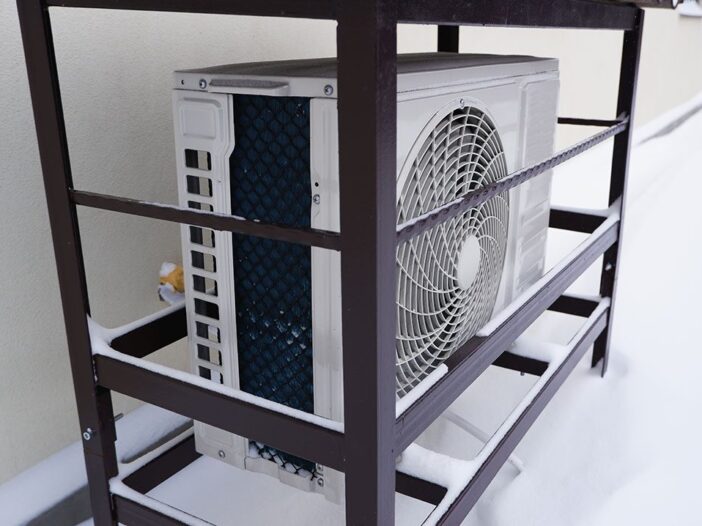
Do Ductless Heat Pumps Work in Cold Climates?
Ductless heat pumps offer countless advantages. They offer zone technology, consistent heat, and high levels of efficiency. But do they work in cold climates? Yes, new heat pumps can work efficiently at negative 13 degrees Fahrenheit.
To help you decide if a heat pump is right for your climate, this guide explains how they work, and it offers tips on how to safeguard efficiency during the installation process.
How Heat Pumps Work in Cold Climates
Heat pumps use a similar process as air conditioners and refrigerators. They use refrigerant to absorb and move heat from place to place. During the winter, the refrigerant in the outside compressor of the heat pump absorbs heat from the air. Even in sub-zero temps, the heat pump can find some heat in the air.
As the refrigerant heats up, it turns from a liquid to a gas. This allows it to easily move through the tubes connecting the inside and outside units. Fans in the indoor air handling unit blow air over the tubes full of hot refrigerant. This pushes warm air into the room. Over time, this process has become much more efficient for cold climates.
The History of Heat Pumps in Cold Climates
Heat pumps originally became popular in relatively warm climates. They worked very efficiently at 35 to 40 degrees, making them ideal for moderate climates. Unfortunately, however, they didn’t work as well at very cold temperatures. As a result, they didn’t catch on in cold climates right away.
However, that trend has changed with the newest generations of heat pumps. Every year, manufacturers have worked hard to make heat pumps even more efficient, and their SEER, HSSPs, and COPs ratings have always improved. But one area where manufacturers have made especially impressive strides is heating efficiently at low temperatures.
Now, modern heat pumps can easily keep homes toasty warm in low temperatures without running up your energy bill. As a result, home and business owners in very cold climates are making the change to these systems.
Using Heat Pumps as Supplemental Heat
In the past, homeowners in cold climates often installed heat pumps as a supplement to their main heating system. The heat pumps would run at the temperatures where they were the most efficient. Then, when the temperature dropped too low for the heat pump, the traditional heating source would take over.
For instance, if it’s 40 degrees outside, a heat pump is much more efficient than using most other types of heat. However, at 10 degrees, the traditional heater was more efficient. The exact switching point varied based on the type of furnace, but for example, some systems might switch from a heat pump to an oil furnace when the outside temperature dropped below 30 degrees.
By switching between a heat pump and a fossil fuel burning system, homeowners could maximize efficiency and comfort. Integrated controls made the process seamless so the homeowners only had to set up the system once. They didn’t have to watch the temperature and then manually switch between the two options.
In the past, a backup heating method was often necessary if you wanted to use a heat pump in a cold climate. Now, this is not necessary. A heat pump can meet all of your needs, even if you live in a cold climate. However, some homeowners still take this route because they like the peace of mind of combining the two heating systems.
Optimizing Heat Pumps for Cold Climates
To efficiently heat your home in cold temperatures, the heat pump must be installed correctly. Keep these tips in mind before installing a heat pump in a cold climate:
- Choose the right size — If it’s too large, it may not offer the efficiency you need, and if it’s too small, it won’t be able to heat your home effectively.
- Position the outside condenser carefully — You need to ensure that the outside condenser doesn’t leak onto sidewalks or driveways where it could create ice.
- Consider excessive snow — If possible, place the outside condenser where it is not likely to get covered in snow and be proactive about shoveling on very snowy days.
- Shield the condenser from wind — When choosing an installation spot, stay away from the wind so it doesn’t force the fan to counter-rotate.
- Insulate refrigerant lines — Refrigerant lines run from the outdoor condenser to the indoor unit, and they should be insulated.
- Seal access holes — You also need to make sure that you seal the holes that you use for line access. If they’re not properly sealed, cold air will seep into your home.
- Tighten your home’s envelope — To maximize the efficiency of your heat pump, you should also make sure that you don’t have any unwanted drafts or leaks.
Installation mistakes can reduce the efficiency of your heat pump. To protect your energy savings, you should always work with a certified installer. This is also important because DIY installations often void equipment warranties.
Heat Pumps for Cold Climates
Heat pumps are now an option for homeowners in cold climates. They can heat your home efficiently in sub-zero temperatures, and they do so quietly, comfortably, and consistently. However, in some cases, you may want to keep your gas or oil boiler and augment it with a heat pump. We can help you assess your home’s needs and make the best decision for your situation.
Ready to learn more? Then, contact us at Jones Services today. We can help you find a heat pump that will keep you warm throughout the coldest New England winters. We work with homeowners in New York, New Jersey, and Pennsylvania, and we would love to work with you.

